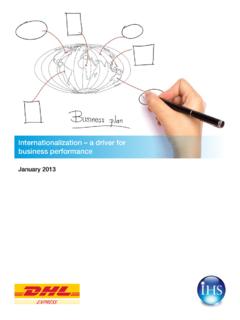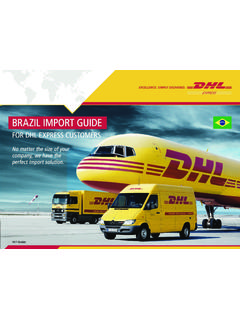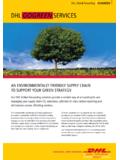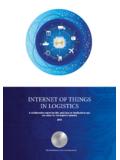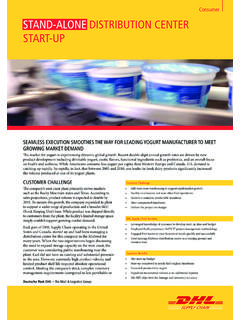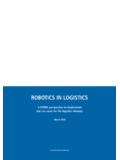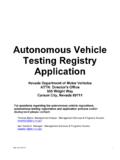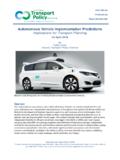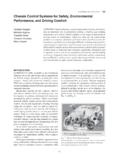Transcription of SELF-DRIVING VEHICLES IN LOGISTICS - DHL Express
1 SELF-DRIVING VEHICLES . IN LOGISTICS . A DHL perspective on implications and use cases for the LOGISTICS industry 2014. Powered by DHL Trend Research PUBLISHER. Represented by Matthias Heutger Senior Vice President DHL Customer Solutions & Innovation 53844 Troisdorf, Germany PROJECT DIRECTOR. Dr. Markus K ckelhaus DHL Trend Research PROJECT MANAGEMENT AND EDITORIAL OFFICE. Katrin Zeiler, Denis Niezgoda, Gina Chung DHL Trend Research IN COOPERATION WITH: Preface 1. PREFACE. Next time you are stuck in slow-moving traffic, you'll You will learn that LOGISTICS provide some of the most possibly want to trade your conventional vehicle for ideal working environments for SELF-DRIVING VEHICLES . an autonomous model. Maybe you would like to read Examples include warehouses and other private and a newspaper, look out at the scenery, or even take a secure indoor locations where goods (not people).
2 Refreshing nap. A switch like this may be possible are loaded and transported, and relatively isolated one day, freeing each driver to do something more and remote outdoor locations where harsh conditions productive and enjoyable with their time. and long hours can put human drivers at risk. Unlike human drivers who sometimes cannot react It's no surprise then that the LOGISTICS industry has fast enough to a sudden road hazard ahead, driving been deploying SELF-DRIVING VEHICLES for several years, assistants or SELF-DRIVING VEHICLES are programmed for and is adopting advances in SELF-DRIVING technology constant vigilance and safety. In addition, these systems more rapidly than many other industries. can find the swiftest route to avoid traffic congestion, reduce motoring costs, and minimize environmental The road to the future is going to be extremely impact, achieving an overall experience that's safer and interesting.
3 Sit back, buckle up, and we hope you greener for everyone. enjoy this trend report! We invite you to join us on a journey to discover Sincerely yours, the incredible potential of autonomous VEHICLES . This trend report examines the distance that needs to be covered before SELF-DRIVING technology reaches full maturity, and addresses the challenges of regulations, public acceptance, and issues of liability. It also shines the headlights on various best-practice applications across several industries today, and takes a detailed look into the existing technology that's successfully used today as well as some future appli- cations for SELF-DRIVING VEHICLES in the LOGISTICS industry. Matthias Heutger Dr. Markus K ckelhaus 2 Table of Contents 1. 1 Understanding SELF-DRIVING 3. Definition and 3.
4 Key 3. Technology 5. Regulations, public acceptance & 8. 2 Current Deployment and Best Practice .. 11. Military & industry 11. Consumer 12. Automotive 13. Public transport 16. 3 Implications for LOGISTICS .. 18. Warehousing 20. Outdoor LOGISTICS 25. Line haul 27. Last-mile 30. Conclusion and Outlook .. 33. 34. Understanding SELF-DRIVING VEHICLES 3. 1 UNDERSTANDING SELF-DRIVING VEHICLES . This introductory chapter sets the scene by providing some common ground for understanding the topic of SELF-DRIVING VEHICLES . It offers a technical definition, describes the current developmental status, and reviews the benefits and technological requirements of auto- nomous driving . This chapter also highlights some key challenges and concerns about driverless VEHICLES , exploring how society will regulate these VEHICLES , whether the general public will accept these VEHICLES , and what changes will be required to insure these VEHICLES .
5 Definition and context SELF-DRIVING VEHICLES have been defined as VEHICLES in which operation occurs without direct driver input to control the steering, acceleration, and braking ,1 according Figure 1: An advertisement for America's Electric Light and Power to the National Highway Traffic Safety Administration. Companies, 1950s; Source: Computer History Museum In this type of vehicle , the driver is not expected to constantly monitor the roadway while operating in Beyond testing, how long will it take before we see SELF-DRIVING mode . the first autonomous VEHICLES on public roads? Some industry analysts predict this could happen This definition assumes that the vehicle will always within the next three years. have a driver. However, this isn't essential autonomous technologies are already able to perform all of the required functions for a vehicle to move safely from Key benefits A to B without anyone on board at all.
6 The hype surrounding autonomous driving clearly The widespread adoption of driverless VEHICLES may seem suggests that there must be advantages to be gained a distant vision something we would expect to see in a from investing in driverless VEHICLES . And these benefits futuristic movie perhaps. However, the reality is that will increase exponentially as more and more people some of the world's leading automotive and technology adopt this method of transportation. companies are already showcasing first prototypes and discussing the advent of the next automotive revolution . Imagine a world where our streets and highways are full First trials of fully driverless VEHICLES are already under- of driverless trucks and cars moving in perfect sync with way. And if you look closely at the VEHICLES on our roads each other.
7 Road traffic accidents caused by human error today, you'll find that many adopt a number of the key will become a thing of the past. Our daily commute to technologies required for autonomous driving . work will be stress-free and safe we'll get into our cars, enjoy a cup of coffee, read the latest news, interact with The race to bring SELF-DRIVING VEHICLES to our roads has other passengers, and even catch up on some sleep! begun, and it is not just the automotive manufacturers The American public had this dream already some that are leading the charge as early as 2011, the US tech 70 years ago (see Figure 1). We'll arrive relaxed and giant Google famously debuted its version of a driverless refreshed at our destination and step out of our VEHICLES car which has since been spotted doing many test rounds and directly in through our office door.
8 We'll leave the on the streets of the US. car to find an available parking space autonomously. +NHTSA/Press+ +Department+of+Transportation+Releases+P olicy+on+Automated+ vehicle +Development 1. 4 Understanding SELF-DRIVING VEHICLES Improved safety: Research indicates that up to 90 % of road traffic accidents are caused by the driver. Advocates for driverless VEHICLES use statistics like this to argue that autonomous systems make better and faster decisions than humans. They also claim that SELF-DRIVING VEHICLES will always monitor and adapt to varying traffic and weather conditions, and will avoid obstacles in the road, doing all this with more diligence, speed, and safety than human Figure 3; Source: Thinkstock Lower environmental impact: With fewer cars and more efficient fuel consumption, autonomous systems are programmed to minimize environmental impact.
9 SELF-DRIVING VEHICLES can achieve lower emissions. This of course benefits the environment and puts less stress on the road Figure 2; Source: Construction Skills Training Higher efficiency: Traffic can flow faster and congestion can be reduced with autonomous driving . Using vehicle - to- vehicle communication, autonomous systems can set high speeds and intelligently avoid busy routes. With fuel efficiency achieved by optimized driving and by convoying, owners of driverless VEHICLES can reduce their carbon footprint and motoring costs by approximately 15 %. Figure 4; Source: Hutchinson In addition, the all-too-familiar time limitations placed on freight trucks will be removed; they will be able to travel 24/7 without requiring driver rest time and . compared with today's driving could achieve overall cost reductions in the region of 40 % per 2.
10 3. 4. Understanding SELF-DRIVING VEHICLES 5. Greater comfort: In an autonomous vehicle , the driver by keeping soldiers and civilians out of danger until mines becomes a passenger. He or she doesn't have to watch the have been detected and safely detonated or disabled. road ahead but can rest and enjoy other activities. This also makes SELF-DRIVING VEHICLES a very attractive form As seen in Figure 1, people have been thinking about of transportation for the elderly, underage, people with SELF-DRIVING VEHICLES for several decades already. Auto- physical disabilities, and even the intoxicated. Parking a nomous VEHICLES were on display as part of the GM. car used to be stressful and time consuming but now Futurama Exhibit at the 1940 New York World's Fair and, the SELF-DRIVING vehicle can find a parking space and, later, by the 1950s, both GM and Ford had running return to a specified pickup point all on its own!
